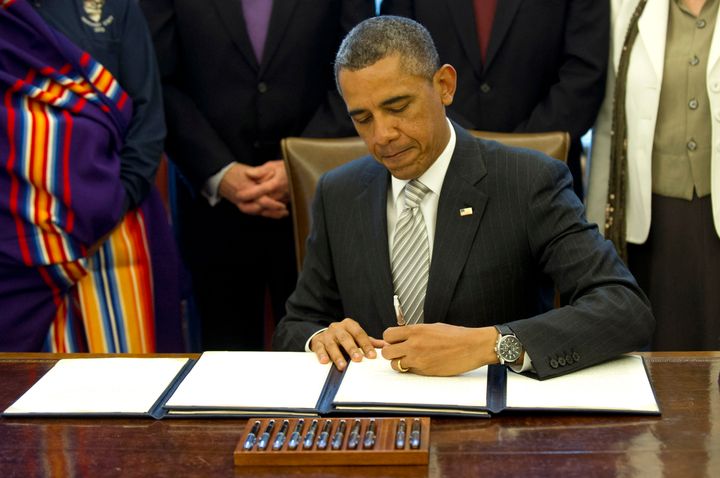
Whether paddling the Potomac River along the boundaries of the C&O Canal National Historical Park with my wife and family, scaling snowy peaks of Mount Rainier National Park, or riding my bicycle to work every day along the National Mall, our national parks are a major ingredient of the places, experiences, and memories that shape my life. With nearly 300 million annual visitors to our National Park System's now 401 sites, our national parks, famously referred to as our country's best idea, continue to get better with age. On March 25, 2013, President Obama designated our 399th, 400th, and 401st national park sites when he used the Antiquities Act to designate the Harriet Tubman Underground Railroad in Maryland, First State in Delaware, and Charles Young Buffalo Soldiers in Ohio as National Monuments.
Since its passage in 1906, the Antiquities Act has been used by eight Republican Presidents and eight Democratic Presidents to designate national monuments. This important law has allowed presidents on both sides of the political aisle to protect California's famous redwood trees from logging, as Theodore Roosevelt did when he created the John Muir National Monument in 1908. Calvin Coolidge protected an ever-lasting symbol of the United States as the land of freedom and opportunity when he designated the Statue of Liberty in 1924. This action was later followed up by Franklin Roosevelt and Lyndon Johnson to include Ellis Island, the historic gateway to America.
Throughout my elementary school years and those of my children, the life and work of Harriet Tubman, one of America's most beloved and respected icons, was discussed in history classes. Now, through the indoor and outdoor "classroom" of the Harriet Tubman Underground Railroad National Monument in Maryland, visitors will be inspired by this hero who rose from an enslaved woman to become the most famous "conductor" on the Underground Railroad as well as a nurse, spy, and scout for the Union army during the Civil War. NPCA has supported the development of a national park site dedicated to Harriet Tubman for nearly a decade, making President Obama's national monument designation all the more special. Our work will continue, until Congress acts to enhance the stories that the National Park Service can share with visitors by creating additional sites commemorating her life's work in Auburn, New York.
When several of NPCA's staff members attended a public meeting in Delaware last August led by Senator Tom Carper and National Park Service Director Jon Jarvis, they were elated by the tremendous turnout of more than 400 local citizens representing multiple business, recreation and conservation constituencies all in favor of bringing a national park presence at long last to our country's first state. Through designating the First State National Monument, President Obama fulfilled a vision set more than a century ago by William Poole Bancroft, who purchased the land just north of downtown Wilmington and less than an hour from Philadelphia with the foresight of preserving an urban oasis in the Brandywine Creek corridor. In addition, the new Monument includes two coastal sites representing the rich history of the 17th century Dutch, Swedish, and English settlers.
In southern Ohio, the Charles Young Buffalo Soldiers National Monument serves as a well-deserved honor for the third African American to graduate from West Point and the first to serve as an acting national park superintendent when he managed Sequoia National Park in 1903. As my colleague Alan Spears eloquently stated in a recent Joy Trip Project article on this new monument, "Colonel Young didn't simply endure that 'bad, worse time' he excelled during it. Young's time in national parks was notable, earning him accolades from admirers, military and civilian alike." With the monument in his honor, Young's legacy will be shared broadly with a wide variety of national park visitors, and will help continue to provide in-roads to connecting all Americans with our national parks.
These three enhancements to our National Park System were not the first time President Obama used the Antiquities Act to help strengthen our "best idea." Last fall, President Obama designated the César E. Chávez National Monument in Keene, California - the first national park site to honor a contemporary Latino American. And in the fall of 2011, the president designated the Fort Monroe National Monument, a new urban national park site that honors America's road from the Civil War to Civil Rights while preserving one of the most impressive coastal forts in North America.
Collectively, the national monuments that President Obama has designated are helping take our National Park System towards a vision shared by the park service, the administration and NPCA. That vision is to have our national parks more adequately reflect our rich and diverse cultural heritage and to better connect urban communities to our national parks. We applaud President Obama for listening and responding to the voices of countless Americans who share our desire to protect and preserve places of great natural, cultural, and historical wonder.
